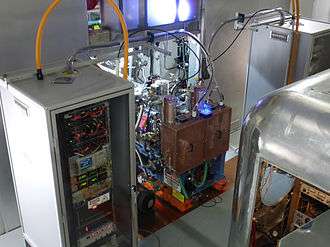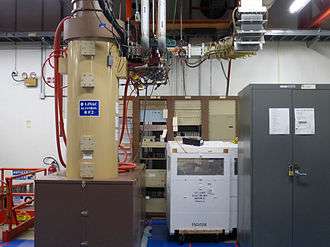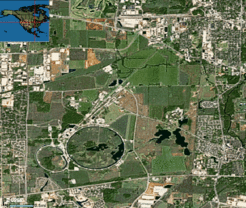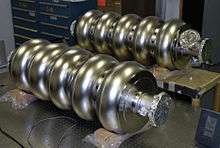Fermilab
|
| |
|
A satellite view of Fermilab. The two circular structures are the Main Injector Ring (smaller) and Tevatron (larger). | |
| Established | November 21, 1967 (as National Accelerator Laboratory) |
|---|---|
| Research type | Accelerator physics |
| Budget | $345 million (2015)[1] |
Field of research | Accelerator physics |
| Director | Nigel S. Lockyer |
| Address | P.O. Box 500 |
| Location | Winfield Township, DuPage County, Illinois, United States |
| Nickname | Fermilab |
| Affiliations |
U.S. Department of Energy University of Chicago Universities Research Association |
| Leon Max Lederman | |
| Website |
www |
Fermi National Accelerator Laboratory (Fermilab), located just outside Batavia, Illinois, near Chicago, is a United States Department of Energy national laboratory specializing in high-energy particle physics. Since 2007, Fermilab has been operated by the Fermi Research Alliance, a joint venture of the University of Chicago, and the Universities Research Association (URA). Fermilab is a part of the Illinois Technology and Research Corridor.
Fermilab's Tevatron was a landmark particle accelerator; at 3.9 miles (6.3 km) in circumference, it was the world's fourth-largest particle accelerator (after CERN's Large Hadron Collider, which is 27 km in circumference, the Large Electron-Positron Collider, which was also 27 km in circumference and the Super Proton Synchrotron, which is 6.9 km in circumference), until it was shut down in 2011. In 1995, the discovery of the top quark was announced by researchers who used the Tevatron's CDF and DØ detectors.
In addition to high-energy collider physics, Fermilab hosts fixed-target and neutrino experiments, such as MicroBooNE (Micro Booster Neutrino Experiment), NOνA (NuMI Off-Axis νe Appearance) and SeaQuest. Completed neutrino experiments include MINOS (Main Injector Neutrino Oscillation Search), MINOS+, MiniBooNE and SciBooNE (SciBar Booster Neutrino Experiment). The MiniBooNE detector was a 40-foot (12 m) diameter sphere containing 800 tons of mineral oil lined with 1,520 phototube detectors. An estimated 1 million neutrino events were recorded each year. SciBooNE sat in the same neutrino beam as MiniBooNE but had fine-grained tracking capabilities. The NOνA experiment uses, and the MINOS experiment used, Fermilab's NuMI (Neutrinos at the Main Injector) beam, which is an intense beam of neutrinos that travels 455 miles (732 km) through the Earth to the Soudan Mine in Minnesota and the Ash River, MN site of the NOνA far detector.
In the public realm, Fermilab hosts many cultural events: not only public science lectures and symposia, but also classical and contemporary music concerts, folk dancing and arts galleries. The site is open from dawn to dusk to visitors who present valid photo identification.
Asteroid 11998 Fermilab is named in honor of the laboratory.
History
Weston, Illinois, was a community next to Batavia voted out of existence by its village board in 1966 to provide a site for Fermilab.[2]
The laboratory was founded in 1967 as the National Accelerator Laboratory; it was renamed in honor of Enrico Fermi in 1974. The laboratory's first director was Robert Rathbun Wilson, under whom the laboratory opened ahead of time and under budget. Many of the sculptures on the site are of his creation. He is the namesake of the site's high-rise laboratory building, whose unique shape has become the symbol for Fermilab and which is the center of activity on the campus.
After Wilson stepped down in 1978 to protest the lack of funding for the lab, Leon M. Lederman took on the job. It was under his guidance that the original accelerator was replaced with the Tevatron, an accelerator capable of colliding proton and an antiproton at a combined energy of 1.96 TeV. Lederman stepped down in 1989 and remains Director Emeritus. The science education center at the site was named in his honor.
The later directors include:
- John Peoples, 1989 to 1999
- Michael S. Witherell, July 1999 to June 2005
- Piermaria Oddone, July 2005 to July 2013[3]
- Nigel Lockyer, September 2013 to the present[4]
Fermilab continues to participate in the work in the LHC; it serves as a Tier 1 site in the Worldwide LHC Computing Grid.[5]
Accelerators
Current state
As of 2014, the first stage in the acceleration process (pre-accelerator injector) takes place in two ion sources which turn hydrogen gas into H− ions. The gas is introduced into a container lined with molybdenum electrodes, each a matchbox-sized, oval-shaped cathode and a surrounding anode, separated by 1 mm and held in place by glass ceramic insulators. A magnetron generates a plasma to form the ions near the metal surface. The ions are accelerated by the source to 35 keV and matched by low energy beam transport (LEBT) into the radio-frequency quadrupole (RFQ) which applies a 750 keV electrostatic field giving the ions their second acceleration. At the exit of RFQ, the beam is matched by medium energy beam transport (MEBT) into the entrance of the linear accelerator (linac).[6]
The next stage of acceleration is linear particle accelerator (linac). This stage consists of two segments. The first segment has 5 vacuum vessel for drift tubes, operating at 201 MHz. The second stage has 7 side-coupled cavities, operating at 805 MHz. At the end of linac, the particles are accelerated to 400 MeV, or about 70% of the speed of light.[7][8] Immediately before entering the next accelerator, the H− ions pass through a carbon foil, becoming H+ ions (protons).[9]
The resulting protons then enter the booster ring, a 468 m-circumference circular accelerator whose magnets bend beams of protons around a circular path. The protons travel around the Booster about 20,000 times in 33 milliseconds, adding energy with each revolution until they leave the Booster accelerated to 8 GeV.[9]
The final acceleration is applied by the Main Injector, which is the smaller of the two rings in the last picture below (foreground). Completed in 1999, it has become Fermilab's "particle switchyard" in that it can route protons to any of the experiments installed along the beam lines after accelerating them to 120 GeV. Until 2011, the Main Injector provided protons to the antiproton ring and the Tevatron for further acceleration but now provides the last push before the particles reach the beam line experiments.
 Two ion sources at the center with two high-voltage electronics cabinets next to them[10]
Two ion sources at the center with two high-voltage electronics cabinets next to them[10] Beam direction right to left: RFQ (silver), MEBT (green), first drift tube linac (blue)[10]
Beam direction right to left: RFQ (silver), MEBT (green), first drift tube linac (blue)[10]- A 7835 power amplifier that is used at the first stage of linac[7]

 A cutaway view of the 805 MHz side-couple cavities[11]
A cutaway view of the 805 MHz side-couple cavities[11] Booster ring[12]
Booster ring[12] Fermilab's accelerator rings. The main injector (circumference 3319.4 m) is in the foreground, and the main ring and Tevatron (circumference 6283.2 m, inactive since 2011) are in the background.
Fermilab's accelerator rings. The main injector (circumference 3319.4 m) is in the foreground, and the main ring and Tevatron (circumference 6283.2 m, inactive since 2011) are in the background.
Proton improvement plan
In recognizing higher demands of proton beams to support new experiments, Fermilab started an initiative to enhance their accelerators. The project started in 2011 and will continue for many years.[13] The project has two phases called Proton Improvement Plan (PIP) and Proton Improvement Plan-II (PIP-II).[14]
PIP (2011–2018)
The overall goals of PIP are to increase the repetition rate of the Booster beam from 7 Hz to 15 Hz and replace old hardware to increase reliability of the operation.[14] Before the start of the PIP project, a replacement of the pre-accelerator injector was underway. The replacement of almost 40-year-old Cockcroft–Walton generators to RFQ started in 2009 and completed in 2012. At the linac stage, the analog beam position monitor (BPM) modules were replaced with digital boards in 2013. A replacement of Linac vacuum pumps and related hardware is expected to be completed in 2015. A study on the replacement of 201-MHz drift tubes is still ongoing. At the boosting stage, a major component of the PIP is to upgrade the Booster ring to 15-Hz operation. The Booster has 19 radio frequency stations. Originally, the Booster stations were operating without solid-state drive system which was acceptable for 7-Hz, but not for 15-Hz operation. A demonstration project in 2004 converted one of the stations to solid state drive prior to the PIP project. As part of the project, the remaining stations were successfully converted to solid state in 2013. Another major part of the PIP project is to refurbish and replace 40-year-old Booster cavities. Many cavities have been refurbished and tested to operate at 15 Hz repetition rate. The completion of cavity refurbishment is expected to be completed in 2015 and the repetition rate can be gradually increased to 15-Hz operation from that point. A longer term upgrade task is to replace the Booster cavities with a new design. The research and development of the new cavities is underway. The completion of the Booster cavity replacement is expected to be in 2018.[13]
PIP-II
The goals of PIP-II include a plan to delivery 1.2 MW of proton beam power from the Main Injector to the Deep Underground Neutrino Experiment target at 120 GeV and the power near 1 MW at 60 GeV with a possibility to extend the power to 2 MW in the future. The plan should also support the current 8 GeV experiments including Mu2e, g−2, and other short-baseline neutrino experiments. These require an upgrade to the linac to inject to the Booster with 800 MeV. The first option is to add 400 MeV "afterburner" superconducting linac at the tail end of the existing 400 MeV. This requires moving the existing linac up 50 metres (160 ft). However, there are many technical issues with this approach. The preferred option is to build a new 800 MeV superconducting linac to inject to the Booster ring. The new linac site will be located on top of a small portion of Tevatron near the Booster ring in order to take advantage of existing electrical and water, and cryogenic infrastructure. The PIP-II linac will have low energy beam transport line (LEBT), radio frequency quadrupole (RFQ), and medium energy beam transport line (MEBT) operated at the room temperature at with a 162.5 MHz and energy increasing from 0.03 MeV. The first segment of linac will be operated at 162.5 MHz and energy increased up to 11 MeV. The second segment of linac will be operated at 325 MHz and energy increased up to 177 MeV. The last segment of linac will be operated at 650 MHz and will have the final energy level of 800 MeV.[16]
Experiments
- Cryogenic Dark Matter Search (CDMS)
- COUPP: Chicagoland Observatory for Underground Particle Physics
- Dark Energy Survey (DES)
- Deep Underground Neutrino Experiment (DUNE), formerly known as Long Baseline Neutrino Experiment (LBNE)
- Holometer interferometer
- MiniBooNE: Mini Booster Neutrino Experiment
- MicroBooNE: Micro Booster Neutrino Experiment
- MINOS: Main Injector Neutrino Oscillation Search
- MINERνA: Main INjector ExpeRiment with νs on As
- MIPP: Main Injector Particle Production
- Mu2e: Muon-to-Electron Conversion Experiment
- Muon g−2
- NOνA: NuMI Off-axis νe Appearance
- SELEX: SEgmented Large-X baryon spectrometer EXperiment, run to study charmed baryons
- Sciboone: SciBar Booster Neutrino Experiment
- SeaQuest
Architecture
Fermilab's first director, Wilson, insisted that the site's aesthetic complexion not be marred by a collection of concrete block buildings. The design of the administrative building (Wilson Hall) harkens back to St. Pierre's Cathedral in Beauvais, France. Several of the buildings and sculptures within the Fermilab reservation represent various mathematical constructs as part of their structure.
The Archimedean Spiral is the defining shape of several pumping stations as well as the building housing the MINOS experiment. The reflecting pond at Wilson Hall also showcases a 32-foot-tall (9.8 m) hyperbolic obelisk, designed by Wilson. Some of the high-voltage transmission lines carrying power through the laboratory's land are built to echo the Greek letter π. One can also find structural examples of the DNA double-helix spiral and a nod to the geodesic sphere.
Wilson's sculptures on the site include Tractricious, a free-standing arrangement of steel tubes near the Industrial Complex constructed from parts and materials recycled from the Tevatron collider, and the soaring Broken Symmetry, which greets those entering the campus via the Pine Street entrance.[17] Crowning the Ramsey Auditorium is a representation of the Möbius strip with a diameter of more than 8 feet (2.4 m). Also scattered about the access roads and village are a massive hydraulic press and old magnetic containment channels, all painted blue.
Current developments
Fermilab is dismantling the CDF (Collider Detector at Fermilab) and DØ (D0 experiment) facilities, and has been approved to continue moving forward with MINOS, NOνA, g−2, and Liquid Argon Test Facility.
LBNF/DUNE
Fermilab has been approved and currently stands to become the world leader in Neutrino physics through the Deep Underground Neutrino Experiment at the Long Baseline Neutrino Facility. Other leaders are CERN, which leads in Accelerator physics with the Large Hadron Collider (LHC), and Japan, which has been approved to build and lead the International Linear Collider (ILC). Fermilab will be the site of LBNF's future beamline, and the Sanford Underground Research Facility (SURF), in Lead, SD, is the site selected to house the massive far detector. The term "baseline" refers to the distance between the neutrino source and the detector. The far detector current design is for four modules of instrumented liquid argon with a fiducial volume of 10 kilotons each. The first two modules are expected to be complete in 2024, with the beam operational in 2026. The final module is planned to be operational in 2027.[18]
LBNF/DUNE plans a world-class program in neutrino physics that will measure fundamental physical parameters to high precision and explore physics beyond the Standard Model. The measurements DUNE will make will greatly increase the physics community's understanding of neutrinos and their role in the universe, thereby better elucidating the nature of matter and anti-matter. It will send the world's highest-intensity neutrino beam to a near detector on the Fermilab site and the far detector 800 miles (1300 km) away at SURF.
g−2
.jpg)

Fermilab is continuing an experiment conducted at Brookhaven National Laboratory to measure the anomalous magnetic dipole moment of the muon.
The magnetic dipole moment (g) of a charged lepton (electron, muon, or tau) is very nearly 2. The difference from 2 (the "anomalous" part) depends on the lepton, and can be computed quite exactly based on the current Standard Model of particle physics. Measurements of the electron are in excellent agreement with this computation. The Brookhaven experiment did this measurement for muons, a much more technically difficult measurement due to their short lifetime, and detected a tantalizing, but not definitive, 3σ discrepancy between the measured value and the computed one.
The Brookhaven experiment ended in 2001, but ten years later Fermilab acquired the equipment,[19] and is working to make a more accurate measurement (smaller σ) which will either eliminate the discrepancy or, hopefully, confirm it as an experimentally observable example of physics beyond the Standard Model.
Central to the experiment is a 50-foot-diameter superconducting magnet with an exceptionally uniform magnetic field. This was transported, in one piece, from Brookhaven in Long Island, New York, to Fermilab in the summer of 2013. The move traversed 3,200 miles over 35 days, mostly on a barge down the East Coast and up the Mississippi.
The magnet was refurbished and powered on in September 2015,[20] and has been confirmed to have the same 1300 ppm p-p basic magnetic field uniformity that it had before the move.[21]:4
As of October 2015 the project is working on shimming the magnet to improve its magnetic field uniformity.[21] This had been done at Brookhaven,[22] but was disturbed by the move and must be re-done at Fermilab.
Particle discovery
On September 3, 2008, the discovery of a new particle, the bottom Omega baryon (
Ω−
b) was announced at the DØ experiment of Fermilab. It is made up of two strange quarks and a bottom quark. This discovery helps to complete the "periodic table of the baryons" and offers insight into how quarks form matter.[23]
Wildlife at Fermilab
In 1967, Wilson brought five American Bison to the site, a bull and four cows, and an additional 21 were provided by the Illinois Department of Conservation. Some fearful locals believed at first that the bison were introduced in order to serve as an alarm if and when radiation at the laboratory reached dangerous levels, but they were assured by Fermilab that this claim had no merit. Today, the herd is a popular attraction that draws many visitors[24] and the grounds are also a sanctuary for other local wildlife populations.[25]
Working with the Forest Preserve District of DuPage County, Fermilab has introduced Barn owls to selected structures around the grounds.
See also
- Big Science
- Center for the Advancement of Science in Space—operates the US National Laboratory on the ISS.
- CERN
- Fermi Linux LTS
- Scientific Linux
- Stanford Linear Accelerator Center
References
- ↑ "DOE Budget Report" (PDF). Retrieved 2014-12-27.
- ↑ Fermilab. "Before Weston". Retrieved 2009-11-25.
- ↑ "Fermilab director Oddone announces plan to retire next year". The Beacon-News. August 2, 2012. Retrieved 10 July 2013.
- ↑ "New Fermilab director named". Crain's Chicago Business. June 21, 2013. Retrieved 10 July 2013.
- ↑ National Science Foundation. "The US and LHC Computing". Retrieved 2011-01-11.
- ↑ Carneiro, J.P.; Garcia, F.G.; Ostiguy, J.-F.; Saini, A.; Zwaska, R. (13 Nov 2014). Transmission efficiency measurement at the FNAL 4-rod RFQ (FERMILAB-CONF-14-452-APC) (PDF). 27th International Linear Accelerator Conference (LINAC14). pp. 168&ndsdh;170. arXiv:1411.3614
 . ISBN 978-3-95450-142-7. Retrieved 12 August 2015.
. ISBN 978-3-95450-142-7. Retrieved 12 August 2015. - 1 2 3 "Fermilab Linac Slide Show Description". Fermilab. Retrieved 12 August 2015.
- ↑ Kubik, Donna (2005). Fermilab (PDF). Retrieved 12 August 2015.
- 1 2 "Accelerator". Fermilab. Retrieved 12 August 2015.
- 1 2 "35 years of H− ions at Fermilab" (PDF). Fermilab. Retrieved 12 August 2015.
- ↑ May, Michael P.; Fritz, James R.; Jurgens, Thomas G.; Miller, Harold W.; Olson, James; Snee, Daniel (1990). Mechanical Construction of the 805 MHz Side Couple Cavities for the Fermilab Linac Upgrade (PDF). Proceedings of the Linear Accelerator Conference 1990. Albuquerque, New Mexico, USA. Retrieved 13 August 2015.
- ↑ "Wilson Hall & vicinity". Fermilab. Retrieved 12 August 2015.
- 1 2 "FNAL – The Proton Improvement Plan (PIP)" (PDF). Proceedings of IPAC2014, Dresden, Germany. pp. 3409–3411. ISBN 978-3-95450-132-8. Retrieved 15 August 2015.
- 1 2 Holmes, Steve (16 December 2013). MegaWatt Proton Beams for Particle Physics at Fermilab (PDF). Fermilab. Retrieved 15 August 2015.
- ↑ Awida, M.H.; Foley, M.; Gonin, I.; Grassellino, A.; Grimm, C.; Khabiboulline, T.; Lunin, A.; Rowe, A.; Yakovlev, V. (September 2014). Development of 5-Cell Beta=0.9 650 MHz Cavities for Project X (PDF). 27th Linear Accelerator Conference (LINAC2014). Geneva, Switzerland. pp. 171–173. ISBN 978-3-95450-142-7. Retrieved 16 August 2015.
- ↑ Proton Improvement Plan-II (PDF). Fermilab. 12 December 2013. Retrieved 15 August 2015.
- ↑ "About Fermilab - The Fermilab Campus". 2005-12-01. Retrieved 2007-02-27.
- ↑ Acciarri, R.; et al. (January 22, 2016). Long-Baseline Neutrino Facility (LBNF) and Deep Underground Neutrino Experiment (DUNE) Conceptual Design Report Volume 1: The LBNF and DUNE Projects. Deep Underground Neutrino Experiment. Retrieved 10 August 2016.
- ↑ Ruppel, Emily (September 30, 2011). "Physics Phoenix: Plotting the Journey of Muon g–2". Brookhaven National Laboratory.
- ↑ Lord, Steve (26 September 2015). "Fermilab brings super magnet to life after 10 years". Aurora Beacon-News – via Chicago Tribune.
- 1 2 Kiburg, Brendan (26 October 2015). G-2 Report (PDF) (Report). Retrieved 2015-12-05.
- ↑ Redin, S.I. (1999). Magnetic Field shimming, Measurement and Control for the BNL Muon (g-2) Experiment (PDF). 1999 Particle Accelerator Conference. New York. doi:10.1109/PAC.1999.792238.
- ↑ "Fermilab physicists discover "doubly strange" particle". Fermilab. 9 September 2008.
- ↑ Fermilab (30 December 2005). "Safety and the Environment at Fermilab". Retrieved 2006-01-06.
- ↑ http://www.fnal.gov/pub/about/campus/ecology/wildlife/ retrieved 3/30/2013
External links
| Wikimedia Commons has media related to Fermilab. |
Coordinates: 41°49′55″N 88°15′26″W / 41.83194°N 88.25722°W


